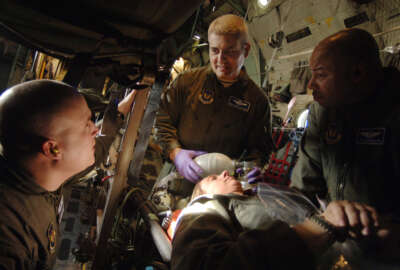
DoD imposes financial sanctions on TRICARE contractor amid ongoing transition problems
Incomplete, inaccurate provider database remains a major problem, 11 months after new vendors took over TRICARE management.
Best listening experience is on Chrome, Firefox or Safari. Subscribe to Federal Drive’s daily audio interviews on Apple Podcasts or PodcastOne.
Nearly a year after new contractors took over the management of the military’s managed health system, TRICARE is still seeing major transition challenges. In response, defense officials say not only have they issued corrective action orders to the two vendors, they’ve imposed financial penalties on at least one of them.
The year got off to a rocky start as the TRICARE system transitioned from a management structure with two regions instead of the previous three, along with new contracts to deliver benefits to beneficiaries in those regions.
The problems have been most acute in the West region, where TRICARE officials initially had to waive the system’s normal preauthorization requirements amid long call center wait times, backlogged enrollments and referrals and delayed payments to providers.
Thomas McCaffery, the administration’s nominee to be the assistant secretary of defense for health affairs, told senators Thursday that some of those challenges remain unsolved, 11 months after the new contracts took effect.
“The Defense Health Agency is exercising some of the tools we have on our contract. We’ve been instituting corrective action plans by which Health Net needs to come back and identify progress to us on a regular basis,” said McCaffrey, who currently serves as the principal deputy in the health affairs office. “Both myself and the DHA director have directly engaged the executive leadership of Health Net and Centene Corporation, their parent, and we’ve utilized contractual ability to financially penalize them. So we use all the tools we have in our contract to hold them accountable.”
At this point, some of the biggest performance issues have to do with Health Net’s ability to maintain an accurate database of private sector health care providers in the TRICARE system, including up-to-date provider names and addresses. McCaffery said Health Net still has not provided a corrective action plan to adequately address that issue.
Sen. Martin Heinrich (D-N.M.) said he has heard much the same thing from his constituents.
“It seems pretty trivial, but it’s a huge problem right now so that military treatment facilities can accurately refer patients,” he said. “Health Net is contractually obligated to maintain 95 percent accuracy in its provider directory, and as of the end of October, they’re not even halfway there: they’re at 42 percent. And when we asked for a plan for how they would achieve 95 percent accuracy, they were completely unwilling to provide one. This level of inaccuracy is not only acceptable, but it’s directly impacting the speed and the quality of care for our military families.”
Reorganization
The transition to new managed service contracts comes amid a series of other major changes happening within the military health system nearly-simultaneously.
Also on Jan. 1., TRICARE restructured its health plans. Right now, it’s is in the midst of its first-ever open season and transitioning its vision and dental plans to the FEDVIP system that serves the rest of the federal government.
And on Oct. 1., on orders from Congress, the Defense Health Agency began taking over the management of military treatment facilities (MTFs) from the Army, Navy and Air Force.
DHA now has administrative control of eight hospitals and clinics across the country. It will absorb the rest of the MTFs on the East Coast within the next year, and West Coast and Overseas clinics will follow in 2020 and 2021.
McCaffery said the initial transition involved some hiccups, but DoD sees clear benefits for long-term military medical readiness.
“The way the system has been structured for the last decades is that each of the services in essence runs its own healthcare system, making sure we have a ready medical force, that we have a medically-ready operational force, and they do that a number of ways, one of which is to run a facilities where our medical providers are military personnel. They get the currency and the skills to be deployed,” he said. “I think one of the benefits of the move to consolidate all of those MTFs under one entity is to free up the medical organizations of each of the services to focus more exclusively on the medical operational readiness requirements. It’s taking off their plate that responsibility for the day-to-day running of a healthcare facility.”
And McCaffery said there’s another benefit: When military medical personnel do have to deploy for overseas operations, temporarily filling their peacetime jobs become get a lot easier.
Related Stories

TRICARE extends waiver for specialty care amid tumultuous transition to new contractors
Meanwhile, as DHA takes on the management of military treatment facilities and tries to take more of an enterprise approach to the military health system, it’s reconsidering how it uses private sector health care providers. In some cases, that might mean that patients who are assigned to MTFs might receive more of their care from off-base clinicians.
“We’re looking market by market to determine what is the best service that we want to retain at our military treatment facilities in that particular market,” McCaffery said. “What are things that we could put out into the marketplace as a way to focus what our MTFs are doing on those clinical issues that are tied most directly to their knowledge, skills and abilities for being deployed? Those are options we’re looking at.”
Copyright © 2024 Federal News Network. All rights reserved. This website is not intended for users located within the European Economic Area.
Jared Serbu is deputy editor of Federal News Network and reports on the Defense Department’s contracting, legislative, workforce and IT issues.
Follow @jserbuWFED




